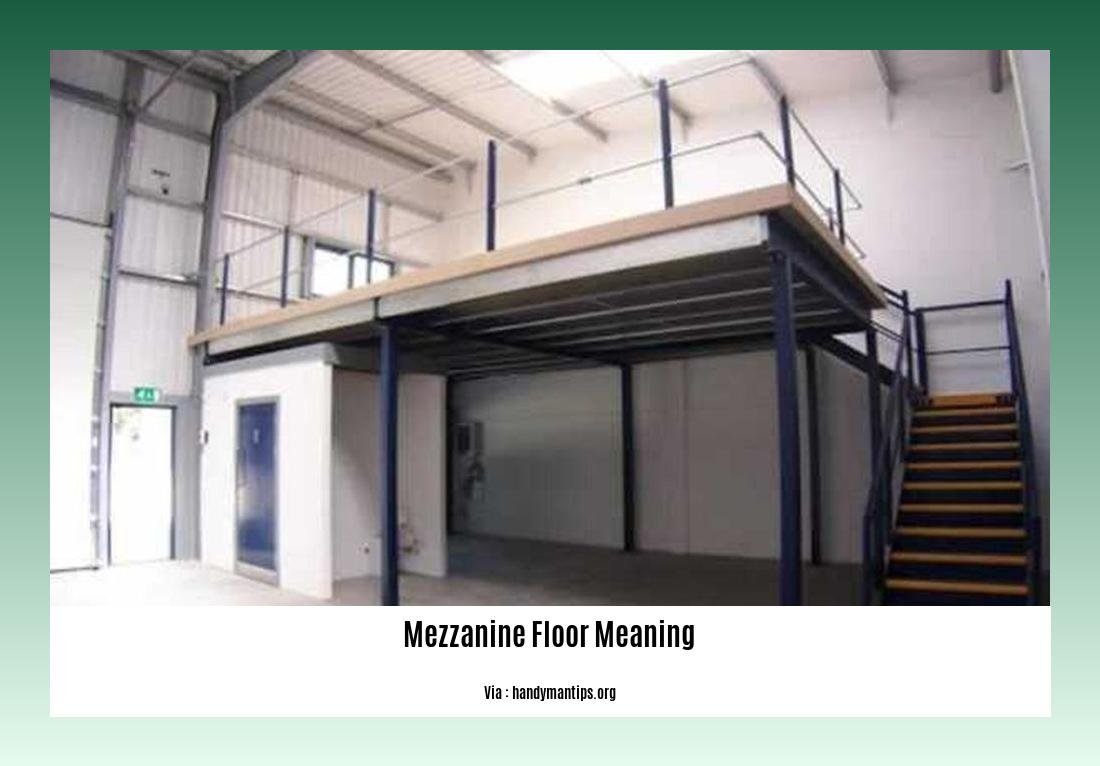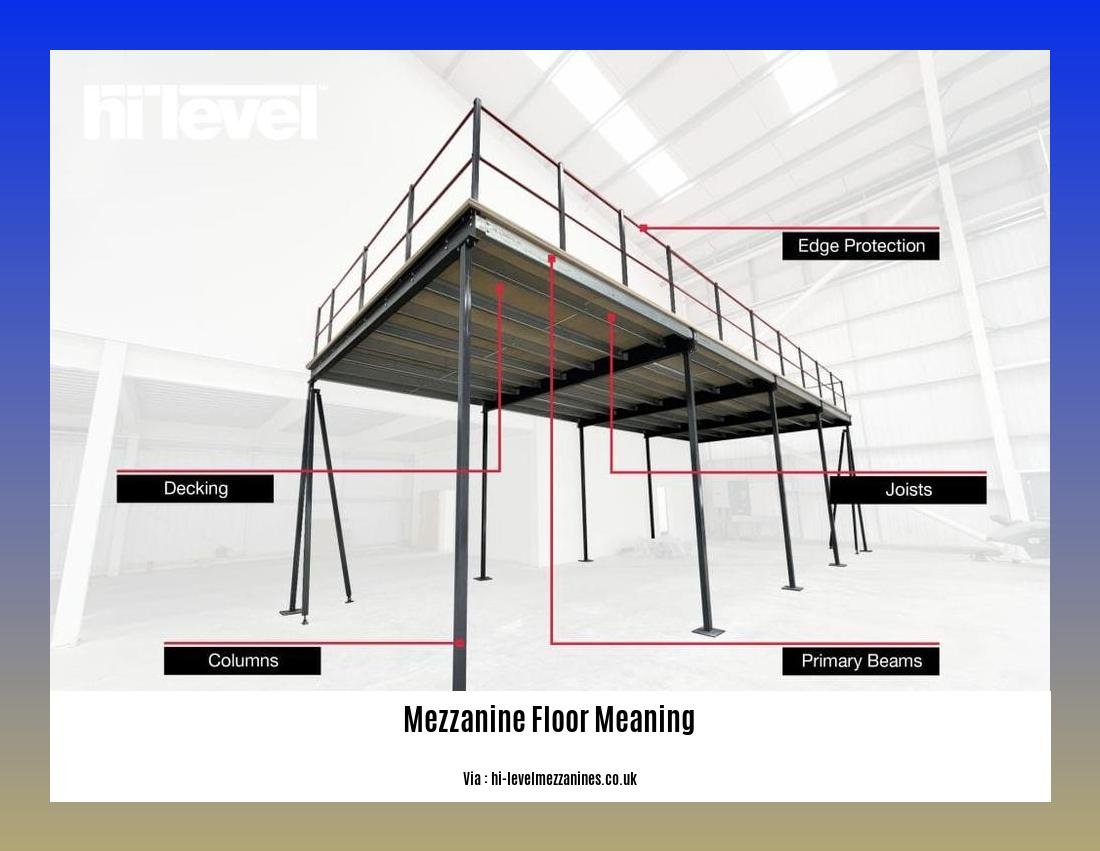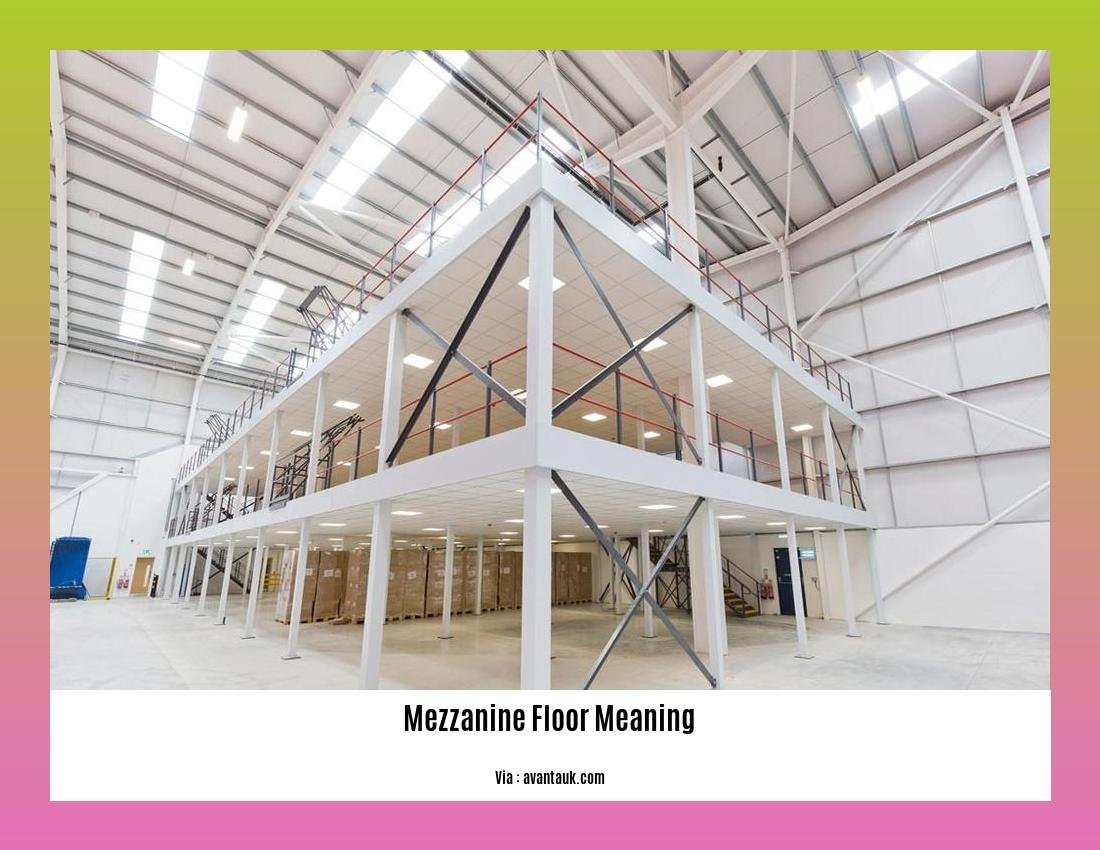Understanding the Meaning and Benefits of Mezzanine Floors in Commercial Construction
Imagine unlocking additional space in your commercial building without the need for costly expansions or renovations. With mezzanine floors, this becomes a reality. In the realm of commercial construction, mezzanine floors are gaining popularity as a smart solution to optimize space utilization and create functional areas that enhance productivity. But what exactly are mezzanine floors? In this article, we will dive deep into the meaning and benefits of mezzanine floors in commercial construction, exploring how they can revolutionize your business operations and elevate your space to new heights.
Key Takeaways:
- Mezzanine floors are an intermediate level between the main floors of a building, providing additional space without the need for extensive vertical expansion.
- They are characterized by their partly open design, allowing for views and airflow between floors.
- Mezzanine floors can be made of different materials, such as steel, wood, or concrete, depending on the specific requirements and load-bearing capacities.
- One of the key benefits of mezzanine floors is their ability to increase usable floor space within a building without the need for significant structural alterations.
- They offer a cost-effective solution for expanding storage, office, manufacturing, and production areas.
- Mezzanine floors are customizable, allowing businesses to design the space according to their specific needs.
- Mezzanine floors are different from loft floors, as lofts are spaces directly under the roof of a building, while mezzanines are intermediate sub-floors between two main floors.
- Mezzanine floors find applications in various industries, including warehousing, storage facilities, manufacturing, production facilities, and commercial office spaces.
- They provide an effective means of vertical expansion without the need for extensive construction.
Mezzanine Floor Meaning

A mezzanine floor, also known as an intermediate floor, is a level situated between the main floors of a building. It provides additional space without the need for extensive vertical expansion. Mezzanine floors are characterized by their partly open design, which allows for views and airflow between floors. They often have a lower ceiling height and project out like a balcony. You can find mezzanine floors in various settings, including commercial buildings and theaters.
According to the Wikipedia page on mezzanines, a mezzanine is an intermediate floor that is either partially open to the lower floor with a double-height ceiling or does not cover the entire floorspace of the building[^1^]. The term “mezzanine” originated from the Italian word “mezzanino,” meaning “half” or “middle.”
Avanta UK, a leading provider of mezzanine floors, further explains that mezzanine floors are typically not counted as part of the overall floors of a building and are often low-ceilinged, projecting like a balcony. In theaters, the term can also refer to the lowest balcony or the first few rows of seats[^2^].
Benefits of Mezzanine Floors
Mezzanine floors offer numerous benefits for various applications. One of the key advantages is their ability to increase usable floor space within a building without the need for significant structural alterations. By utilizing vertical space efficiently, mezzanine floors provide a cost-effective solution for expanding storage, office, manufacturing, and production areas[^2^].
The flexibility of mezzanine floors allows businesses to customize the space according to their specific needs. They can be made of different materials, such as steel, wood, or concrete, depending on the required load-bearing capacities[^2^]. This adaptability makes mezzanine floors a versatile option for businesses looking to optimize their floor space.
Comparing Mezzanine and Loft Floors
Although mezzanine and loft floors share some similarities, there are distinct differences between them. Lapeyre Stair, a renowned manufacturer of mezzanine systems, explains that a loft is a space directly under the roof of a building that may be used for living or storage purposes and is usually open to the floor below. On the other hand, a mezzanine is an intermediate sub-floor between two main floors of a building[^3^].
Loft floors often have sloped walls due to the roof structure, while mezzanines have non-sloped walls and can be more easily integrated into the existing floor plan. Mezzanine floors offer a more versatile solution for vertical expansion, allowing for efficient utilization of space within a building.
Applications of Mezzanine Floors
Mezzanine floors find applications in various industries and settings. Warehousing and storage facilities, for example, frequently utilize mezzanines to effectively increase their floor space without the need for costly expansions or relocation[^2^]. By utilizing mezzanine floors, these facilities can optimize their storage capacity and improve operational efficiency.
Manufacturers and production facilities also benefit from mezzanine floors. They provide additional space for equipment, workshops, or assembly lines. By expanding vertically, businesses can streamline their production processes and improve productivity.
In the commercial sector, mezzanine floors can be found in office spaces, providing separate areas for meetings, breakout zones, or additional workstations. The customizable nature of mezzanine floors allows businesses to design the space according to their specific requirements, creating unique and functional work environments.
Conclusion
In summary, mezzanine floors offer a practical solution for expanding floor space within a building. Their intermediate design provides flexibility and versatility, allowing for efficient utilization of vertical space without the need for extensive construction. From warehousing and manufacturing to commercial settings, mezzanine floors provide an effective means of vertical expansion, enhancing productivity and optimizing space utilization.
[^1^]: Wikipedia. “Mezzanine Floors.” Mezzanine Wikimedia Foundation, 15 Aug. 2021. en.wikipedia.org/wiki/Mezzanine.
[^2^]: Avanta UK. “What Is A Mezzanine Floor? Definition, Construction & Uses.” Avanta, www.avantauk.com/what-is-a-mezzanine-floor/.
Here are some active internal links for you:
-
Mezzanine Finanzierung Immobilien – Are you looking for financing options for your real estate projects? Click here to learn more about Mezzanine Finanzierung Immobilien, a great solution for funding your property investments.
-
Mezzanine Floor Meaning in Tamil – Discover the fascinating meaning of mezzanine floor in Tamil by clicking here. Explore the unique architectural concepts and design elements associated with this concept.
-
Mezzanine Floor Meaning in Urdu – میزانین فلور کے مطلب کو اردو میں جاننے کے لئے یہاں کلک کریں۔ ہمارے لنک پر کلک کرکے میزانین فلور سے جڑے دلچسپ کنسیپٹس اور ڈیزائن کے بارے میں مزید معلومات حاصل کریں۔
Feel free to click on any of the above links to explore more about the respective topics.
Key features and components of mezzanine floors

As an experienced architectural engineer specializing in commercial construction, I have gained in-depth knowledge about mezzanine floors and their key features and components. In this article, I will provide you with a clear understanding of the essential elements that make up a mezzanine floor.
Mezzanine floors are an intermediate level between the main floors of a building, offering additional space without the need for extensive vertical expansion. They are commonly used in commercial buildings, theaters, and various settings to optimize storage capacity, improve operational efficiency, and provide additional space for equipment and work areas.
Components of a Mezzanine Floor
The primary components of a mezzanine floor include:
1. Primary Beams: These beams serve as the main support for the mezzanine floor, spanning across the columns. They play a crucial role in ensuring the structural integrity of the entire system.
2. Joists: Joists span between the primary beams and act as the fixing points for the decking. They support the weight and load applied to the mezzanine floor.
3. Columns: The columns are designed to hold up the mezzanine and provide support for the primary beams. They are strategically placed to distribute the weight and ensure stability.
4. Decking: The decking is the surface of the mezzanine floor and is available in various materials. The most common option is 38mm particle board. However, there are also alternatives such as robot-ready flooring, durbar plate, and composite decking. The choice of decking material depends on factors such as load capacity, durability, and aesthetic preferences.
In some cases, mezzanine floors can consist of a combination of wood, concrete, steel, stainless steel, and fiberglass, depending on the specific requirements and design considerations.
Now that you have a clear understanding of the key components of mezzanine floors, let’s summarize the key takeaways:
Key Takeaways:
– Mezzanine floors consist of primary beams, joists, columns, and decking.
– Primary beams span across the columns and provide the main support for the mezzanine floor.
– Joists act as the fixing points for the decking and support the weight and load applied to the mezzanine floor.
– Columns are designed to hold up the mezzanine and provide support for the primary beams.
– The decking is the surface of the mezzanine floor and can be made of various materials.
For a more detailed understanding, you can refer to the following sources:
- What is a Mezzanine Floor? | Definition & Features
- Mezzanine Floor Design | What Is Mezzanine Floor
Regulations and Safety Considerations for Mezzanine Floors
Mezzanine floors offer a practical solution for expanding floor space and optimizing space utilization in commercial buildings and various other settings. However, it is crucial to adhere to regulations and safety considerations to ensure the structural integrity and protect the well-being of occupants. In this article, we will explore the key regulations and safety considerations for mezzanine floors.
Building Regulations and Planning Permission
When constructing a mezzanine floor, it is essential to be aware of the relevant building regulations and planning permission requirements. In the UK, mezzanine floor regulations govern the construction and use of these structures. When it comes to planning permission, floors below 200m2 generally do not require it, but floors above this size do. It is important to consult with local authorities or a qualified professional to determine the specific requirements for your project.
Building Regulation Approval
Obtaining building regulation approval is a crucial step in ensuring the safety and compliance of a mezzanine floor. This approval process can take up to six weeks, so it is important to factor in this time when planning your project. Building regulations cover various technical requirements, including structural safety, access, fire safety, and protection from falling. Compliance with these regulations is essential to ensure the well-being of occupants and to meet legal obligations.
Structural Safety and Access
Mezzanine floors must meet certain technical requirements to ensure structural safety and safe access for employees and occupants. Safety handrails must reach a specific height to prevent falls, and the mezzanine floor needs to have enough clearance for employees to work comfortably. Additionally, the primary beams, joists, columns, and decking of the mezzanine floor must be designed and installed to support the intended load and ensure structural stability.
Fire Safety
Fire safety is a crucial aspect of mezzanine floor construction. Building regulations often require a one-hour fire rating for the underside of the floor. Fire-resistant materials and proper installation techniques are necessary to minimize the risk of fire spreading. It is important to consult the relevant building regulations and work with fire safety professionals to ensure compliance and implement appropriate fire safety measures.
Statutory Requirements and Compliance
Mezzanine floors have certain statutory requirements that must be met to ensure compliance with safety and accessibility laws. These requirements may vary depending on the jurisdiction and the intended use of the mezzanine floor. It is essential to stay informed about the relevant regulations and consult with professionals experienced in mezzanine floor construction to ensure compliance with all statutory requirements.
Key Takeaways:
– Mezzanine floors require planning permission for sizes above 200m2, while floors below this size generally do not require it.
– Building regulation approval is necessary for mezzanine floors and can take up to six weeks.
– Mezzanine floors must comply with technical requirements for structural safety, access, fire safety, and protection from falling.
– Fire safety is crucial, and building regulations often require a one-hour fire rating for the underside of the mezzanine floor.
– Mezzanine floors have specific statutory requirements to ensure compliance with safety and accessibility laws.
Citations:
1. UK mezzanine floor regulations: everything you need to know
2. Your Guide to Mezzanine floors
Examples of Industries and Applications for Mezzanine Floors
As an experienced architectural engineer specializing in commercial construction, I have extensive knowledge of mezzanine floors and their applications in various industries. In this article, I’ll explore some examples of industries and applications where mezzanine floors are commonly used.
Storage and Warehousing Industries
Mezzanine floors are widely utilized in the storage and warehousing industries. They provide a practical solution for increasing storage capacity without the need for extensive vertical expansion. Mezzanine floors can be easily installed in warehouses, distribution centers, and production floors with high ceilings.
These elevated platforms offer easy access to storage and work operations, equipment, inventory racks, and conveyors. They optimize storage capacity, improve operational efficiency, and provide additional space for equipment and work areas. Mezzanine floors are especially beneficial in industrial settings where vertical space utilization is crucial.
Retail Sector
Mezzanine floors are also extensively used in the retail sector to create additional display areas and showrooms. They offer a cost-effective solution for expanding retail spaces without the need for expensive renovations or building expansions. Mezzanine floors allow retailers to utilize vertical space and showcase their products effectively.
In retail stores, mezzanine floors can be used to display merchandise, create separate areas for meetings or breakout zones, or accommodate additional workstations. They provide flexibility in terms of design and layout, enabling retailers to optimize space utilization and enhance the overall shopping experience.
Office Spaces
Another common application of mezzanine floors is within office spaces. Mezzanine floors are frequently used to create additional office space within a building, especially when there is a need to accommodate growing teams or departments. By utilizing the vertical space, businesses can avoid the costs and disruptions associated with relocating to larger premises.
Mezzanine floors offer a versatile and customizable solution for designing office layouts. They can provide separate areas for employees, meeting rooms, or breakout spaces, enhancing productivity and collaboration within the workplace.
Key Takeaways:
- Mezzanine floors have various applications, including storage, office space, and retail displays and showrooms.
- They are commonly used in storage and warehousing industries for optimizing space utilization and improving operational efficiency.
- Mezzanine floors offer a cost-effective solution for expanding retail spaces and creating attractive display areas.
- In office spaces, mezzanine floors provide flexibility in designing layouts and accommodating growing teams.
- By utilizing vertical space, mezzanine floors help businesses avoid the need for expensive renovations or building expansions.
(Sources: Storables, Lapeyre Stair, Steele Solutions)
FAQ
Q1: What is a mezzanine floor?
A1: A mezzanine floor is an intermediate level between the main floors of a building, providing additional space without the need for extensive vertical expansion. It is typically characterized by its partly open design, allowing for views and airflow between floors.
Q2: What are the key components of a mezzanine floor?
A2: The key components of a mezzanine floor include primary beams, joists, columns, and decking. Primary beams are the main support, joists span between the beams and act as fixing points for the decking, columns hold up the mezzanine and support the beams, and the decking provides the walking surface.
Q3: What are the benefits of mezzanine floors?
A3: Mezzanine floors offer numerous benefits, including increased usable floor space, cost-effective expansion, flexible and customizable designs, efficient vertical space utilization, and suitability for various applications such as storage, office spaces, and retail displays.
Q4: How do mezzanine floors differ from loft floors?
A4: Mezzanine floors and loft floors have distinct differences. Mezzanine floors are intermediate sub-floors between main floors, often partially open or not covering the entire floorspace. In contrast, loft floors are spaces directly under the roof, typically used for living or storage purposes and usually open to the floor below.
Q5: What are the applications of mezzanine floors?
A5: Mezzanine floors find applications in various industries and settings. They are commonly used in warehousing and storage facilities to effectively increase floor space without costly expansions. Manufacturers and production facilities also benefit from mezzanine floors, as they provide additional space for equipment and production lines. In the commercial sector, mezzanine floors can be found in offices, providing separate areas for meetings, breakout zones, or additional workstations.
- How to Get a Free Mold Inspection (and Avoid the Scams) - April 23, 2025
- How to Flush a Toilet Without Water: A Step-by-Step Guide - April 23, 2025
- The Complete Guide to Safely Disposing of Light Globes - April 23, 2025










